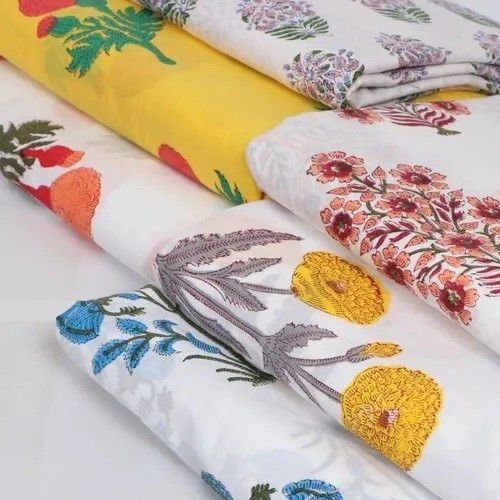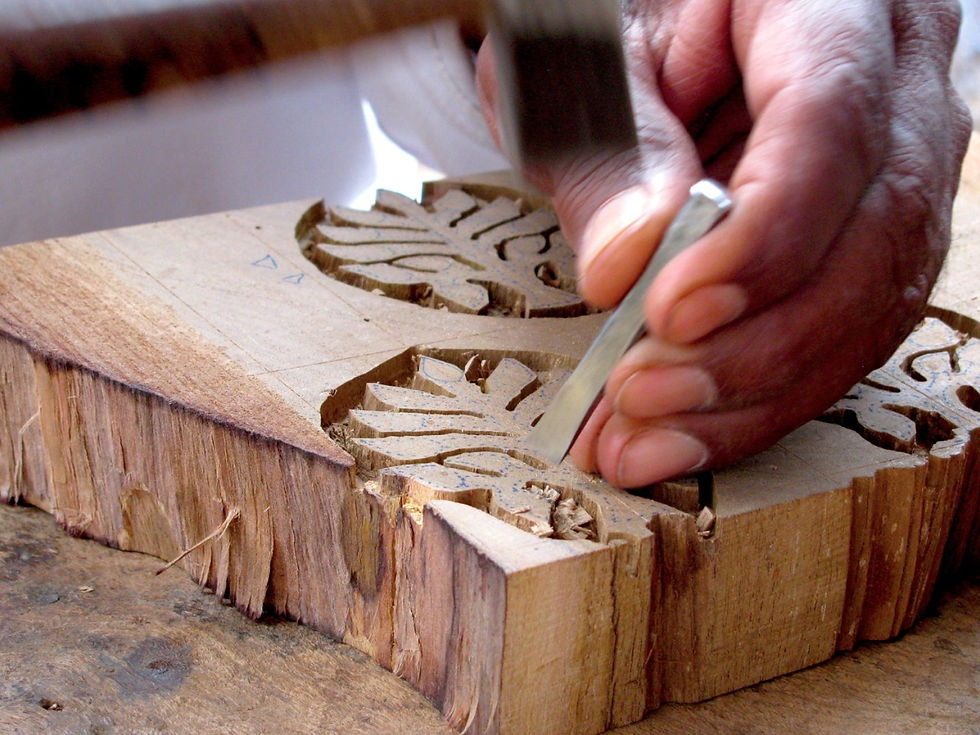
Beautiful floral and geometric patterns adorn the fabric in colors so vibrant and varied - oh so lovely and mesmerizing, a work of art or a crescendo of blocks. Block printing is an art where the fabric is given a new avatar through creating beautiful patterns with the help of blocks and dyes.
Thought to have its origin in China some 4000 years ago, the earliest record of block printing, though, isn’t on fabric but on a book known as the Diamond Sutra, which was printed 300 years before the Gutenberg Bible. Its advent in India came a little later - some 450 years ago when blocks started being used for crafting beautiful textiles.

The recorded history of block printed fabrics dates back to the Indus Valley civilization, around 3500 to 1300 BC. The export of textiles, especially cotton was prevalent during Harappan times. During the Mohenjodaro site excavation, needles, spindles, and cotton fibres dyed with Madder (a red dye or pigment obtained from the root of the madder plant) were excavated.
The oldest record of Indian block print cotton fragments was excavated at various sites in Egypt, at Fustat near Cairo. However, in India, block printing flourished under the patronage of the Mughals. Mughal rulers patronized the arts extensively throughout their dynasty and the Mughal style came to define huge parts of Indian artistry as we know it today, touching everything from block printing to the Taj Mahal.
The Mughal rulers were very fond of Block printing, and it was their favourite. Shah Jahan was known for his expensive taste in textiles. The entire textile industry flourished under the Mughal patronage, and many craftspeople are still working in the same historical centres of Gujrat and Rajasthan that supported the Mughals during their reign.

The techniques of block printing remain unchanged as it is usually done by hand. Most block-printed textiles come about in one of three ways: direct, resist, or discharge printing. The pre-Mughal block printing designs were influenced by geometric forms, whereas the Mughal period saw the designs taking a curvilinear approach with a lot of intricate floral motifs taking centerstage.
The whole process of block printing is an art and does not just involve just pressing the blocks onto the fabric. The wooden blocks are hand carved by artisans who have learned the art of carving from their families. Carving a block requires a delicate but deft hand. Carvers create a block for each element of the pattern, which means that within one pattern there are blocks for every border, leaf grouping, or flower style.

The carving of the outline block or the “rek” must be done in a very precise way and this is usually done by the master carver. The outline block is the most expensive block. The design is first outlined on paper which is then used as a map by the carver to make the design. Sheesham and Teak wood is used for making the blocks, however, blocks made out of Sheesham wood are preferred. It takes a whole lot of experience to carve the blocks precisely according to the design.

How many blocks does it take to make a complete design? Well, it depends on the design. Each element and colour of the design requires a separate block. A simple design might require just three blocks, but a complex design may need up to 30 blocks!
After the blocks have been carved, they must be dipped in mustard oil for a few days before they can be used for printing. The reason behind this is that the wood absorbs moisture and may warp. So, to avoid warping, blocks must be dipped in mustard oil.
Before the printing starts, the fabric must be prepared. It must be washed free of starch. If dyeing is needed, it is done at this stage, and if the fabric is already dyed, it is washed to remove excess colour, post which it is dried in the sun. The next step sees the fabric pinned on the printing table. Meanwhile, the colours are prepared and kept on a tray containing glue and pigment binder to ensure a soft base for the colour, and to allow it to easily spread on the block.

The dye or the colour is then applied using one of three methods. The direct method is the simplest: Dip a block into a dye, and then stamp it onto the fabric. Discharge printing is used to create a white pattern on a colourful background. Printers place a simple bleaching agent on the wooden blocks and stamp them to achieve this. Resist printing happens in reverse. The wooden blocks are dipped in a waxy paste and stamped to create a pattern before the entire piece is dyed the final colour. Once it is dried, the paste is removed, and the untouched pattern remains.

This process is repeated until the length of the fabric is complete. The artisans must be meticulous to ensure there are no breaks in the motifs. If there are multiple colours, other blocks are used, and the artisan waits for the first print to dry first.
The famous centres for block printing in Rajasthan are Jaipur, Bagru, Sanganer, Pali and Barmer. Bagru is renowned for its Syahi Begar and Dabu prints (that come in yellow and black and are done using the resist printing technique). Sanganer is famous for its Calico prints (recognised by their dual colour prints done repeatedly in diagonal rows) and Do Rookhi prints (that come on both side of the fabric). Barmer is known for its prints of red chillies and trees featuring a blue-black outline and Sikar and Shekhawat prints feature motifs of horses, camels, peacocks and lions.

In Gujarat, well-known block printing centres are in Dhamadka, Kutch, Bhavnagar, Vasna, Rajkot, Jamnagar, Jetpur and Porbandar. Ajrakh hand block printing is done in Dhamadka, and feature geometric motifs made using natural colours.

Bagh Print is a traditional hand block print with natural colours, an Indian Handicraft practised in Bagh, Dhar district in Madhya Pradesh, India. Its name is derived from the village Bagh on the banks of the Bagh River. Here, mostly natural dyes are used for printing the fabric - so you would see hues of black and red on a white or off-white background. The designs are inspired by nature, wildlife, architecture and the ancient Bagh Cave paintings.

In Andhra Pradesh, the block printing technique is practiced in the form of Kalamkari. The main centres of its practice are Sri Kalahasti and Masulipatnam. In its execution various natural resources such as myrobalan and buffalo milk are used as tanning and mordant agents to adhere the print to the fabric.

India has a rich heritage in weaving, block printing, tie and dye and various other crafts. It is for us to take these crafts forward and promote them. Not only are these sustainable but they also provide livelihoods to thousands of weavers and artisans involved in this industry.
#heritage #printing #blockprinting #textiles #textilesofindia #textile #textiledesign #craft #craftsofindia #artisans #artisanal #fashion #fabricdesign #fabrics #design #designcommunity

Comments